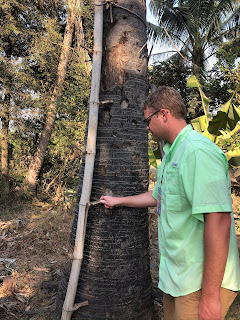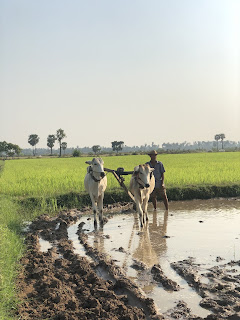SDARL class X arrived in Cambodia this morning. We met our tour guide Sam who will be showing us around for the next three days.
Sam, our Cambodian guide
Sam gave us some background on Cambodia as we hit the ground running on the first day. Cambodia has been harshly affected by years of war. We will see and hear more on how war has shaped both Sam and his country directly, indirectly and from within. Direct affects came from war with the neighboring countries of Thailand and Vietnam and years of French colonization. Indirect affects came from the US bombing of the Cambodian portion of the Ho Chi Minh Trail during the Vietnam Nam war. The trail was a North Vietnamese supply route to move soldiers and supplies from North Vietnam, through Laos and Cambodia back into South Vietnam. Lastly were affects from within when the Khmer Rouge regime caused the death of nearly half their population from 1975 to 1979.
The total population of Cambodia is 16 million people. Out of the 16 million people 80% of them are farmers.
In the country side the single dwelling homes we saw yesterday had the same style. The homes are built on stilts but most with one side built higher than the other. Newer ones had a cement foundation on one side and the older ones were elevated about 5 or 6 feet with the other side of both styles elevated about 10 feet. They are built this way for three reasons. First because of the flooding. Second for shade during the hot days. Third reason is for storage.
The average annual income outside of the city is $400 per month, in the city $1100 per month and in the floating village, similar to what we experienced on the Mekong River in Vietnam, $500 per month. Only 46% of the rural population can read and write. The children in Cambodia either go to school in the morning session or afternoon session. They do this because of shortage of teachers and classroom space.
There are two main seasons in Cambodia. One season is dry and one season is rainy.
The rainy season is June through October. Flying in and touring on the bus, it is noticeably dry and brown where it isn’t irrigated.
Our first stop was one of the four highlight temples in Cambodia, Banteay Srey Temple. This temple was constructed around the year 967. This one and many of the other temples in Cambodia have fallen prey to weather, time, robbers and in some cases part of them are nearly buried by termite mounds. There are more than 1000 Temples throughout the country. Cambodia is 96% Buddhist and worship attendance varies in the faith. There is a Buddhist feast day of celebration every 8 days and the more devout followers go to temple on those days.
Entering the temple
Sam explaining how the walls were constructed
Tom and Garrett
Gods of the temple
Detail of the carvings
Our next stop was an enjoyable traditional Cambodian meal at Bong Thom Forest Lodge.
Matt, Jackson and the crew
After lunch we visited the Cambodia Landmine Museum, founded as a museum and school in 1997 by Aki Ra to help kids in need. Mr. Ra was a soldier involuntarily conscripted as a child into the army of the Khmer Rouge. He spent most of his youth fighting and was good at using land mines. After the war, he returned home to help his country and not hurt it anymore, He was, and is active in finding and disarming the many tons of land mines and unexploded munitions still buried in parts of the county. There were more than 10 million landmines buried throughout the country. Right now in Cambodia 6 million hidden mines, roughy half, still remain today.
A Palm Sugar Tree farm was our fourth stop of the day. The Palm Sugar Tree is the National tree of Cambodia. They can get 2-5 bamboo containers of sugar syrup from each tree a day. There are male and female trees, of course the female trees produce more sugar. We were able to taste test the palm sugar juice and it was delicious.
Climbing the palm tree
In the palm tree to harvest palm
Cooking the palm sugar
Tom ponders whether to climb and harvest
Garrett tries the Rice noodles made from scratch & boiled for all to observe process
The farmer’s daughter
On fifth stop of the day, we enjoyed a visit to a local rice farm. Where a local farmer was plowing his field with two new young oxen. The two oxen cost $1100 each. His wife followed behind planting the rice plant. 30% of the farmers have sold their livestock and now use a tractor. We were greeted with music, experienced a Cambodia speaclity of rice and black beans cooked with palm sugar in the husk of sugar cane.
The oxen make the indentation with hooves to plant rice
Grant helps plant the rice the oxen have left spaces for
Tanse decides to be manager and make sure Grant is doing it correctly
The children enjoyed being part of our tour today
Lorrin won over the children’s hearts
This is the sugar palm stalk they cooked the rice and beans in
Ingredients that go into the sugar palm stalks
Our last tour before checking into our hotel is a rice noodle farm. They grind the rice to make rice flour that is used to make the rice noodles. They then use a big stone to press the water out. After the press, they boil boil the powder in water. Next they pound the boiled powder and put the product into a noodle mold. The noodle drops from the mold right into the hot water to cook the noodle. The elder woman had even been the featured chef on the front cover of the “Chef’s of Cambodia” national magazine,
At each stop, we were greeted by the families who use their agriculture enterprises to make a living in production Ag as well showcase it as a way to ad value to their work. They had all prepared places for us to sit, mingle and experience their products interacting with the whole family.
All were treated to a nice plate served dinner and with entertainment consisting of traditional Cambodian music and dancing.
At each stop, we were greeted by the families who use their agriculture enterprises to make a living in production Ag as well showcase it as a way to ad value to their work. They had all prepared places for us to sit, mingle and experience their products interacting with the whole family.
All were treated to a nice plate served dinner and with entertainment consisting of traditional Cambodian music and dancing.
Reporter: ReEtta Sieh, Photographers: Jackson Waage, Garrett Masat & Tyler Urban




















I cannot thank lemeridian funding service enough and letting people know how grateful I am for all the assistance that you and your team staff have provided and I look forward to recommending friends and family should they need financial advice or assistance @ 1,9% Rate for Business Loan .Via Contact : . lfdsloans@lemeridianfds.com / lfdsloans@outlook.com. WhatsApp...+ 19893943740. Keep up the great work.
ReplyDeleteThanks, Busarakham.
I GOT CURED FROM HERPES VIRUS I was diagnosed of HERPES virus and i have tried all I can to get cured but all to no avail,,until I saw a post in a health forum about a herbalist man who prepare herbal medications to cure all kind of diseases including #HERPES virus,at first I doubted if it was real but decided to give it a try,when I contacted this herbalist via his email and he prepared a #HERPES herbal cure and sent it to me via DHL delivery company service, when I received this herbal medicine, he gave me step by direction on how to apply it,after applying the way I was instructed,I was totally cured of this deadly disease called HERPES, all thanks to Dr OGODO Email this great herbal doctor via his email Ogodoherbalhomesolution@gmail.com
ReplyDeleteYou can also WhatsApp him on +2349044680467
HE CAN ALSO CURE SICKNESS LIKE
{1}HIV/AIDS
{2}DIABETES
{3}EPILEPSY
{4} BLOOD CANCER
{5} HPV
{6} ALS
{7} HEPATITIS
{8}LOVE SPELL
{9} SICKLE AND ANEMIA
Only DR OGODO Can Help You I Love You Father.